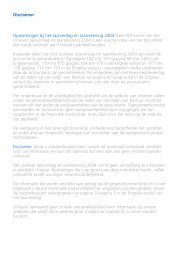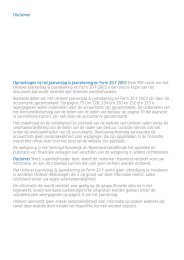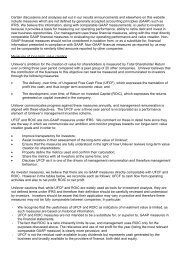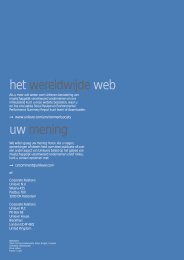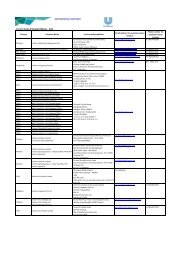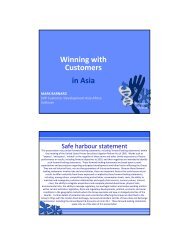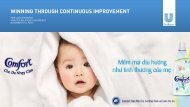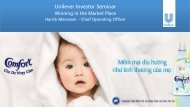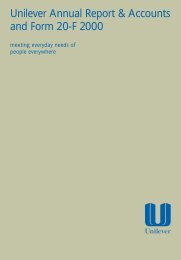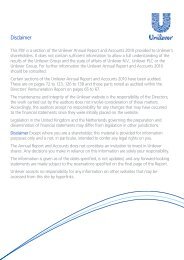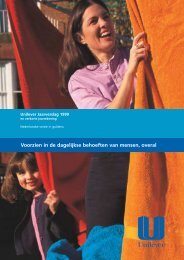Unilever Sustainable Living Plan Progress Report 2011
Unilever Sustainable Living Plan Progress Report 2011
Unilever Sustainable Living Plan Progress Report 2011
You also want an ePaper? Increase the reach of your titles
YUMPU automatically turns print PDFs into web optimized ePapers that Google loves.
40 <strong>Unilever</strong> <strong>Sustainable</strong> <strong>Living</strong> <strong>Plan</strong> <strong>Progress</strong> <strong>Report</strong> <strong>2011</strong><br />
veriFying<br />
oUR APPRoAcH<br />
We value independent opinion and input on our approach.<br />
governance<br />
Achieving our goals requires commitment<br />
at all levels of the organisation. We have<br />
strong governance structures in place to<br />
manage our sustainability programme<br />
and ensure it becomes embedded in<br />
our business.<br />
Implementation and delivery of the <strong>Plan</strong><br />
is monitored quarterly by the <strong>Unilever</strong><br />
Leadership Executive – led by the cEo.<br />
Four members of this group have<br />
sustainability as part of the targets which<br />
determine their levels of reward: the cEo,<br />
the chief Marketing and communication<br />
officer and two category Presidents.<br />
The Executive is supported by the <strong>Unilever</strong><br />
<strong>Sustainable</strong> <strong>Living</strong> <strong>Plan</strong> Steering Team<br />
which includes our category Presidents<br />
and the leaders of key business functions.<br />
The role of the Board’s corporate<br />
Responsibility and Reputation committee<br />
is to oversee <strong>Unilever</strong>’s conduct as a<br />
responsible business. It comprises three<br />
independent non-Executive Directors and<br />
is given regular updates on the <strong>Plan</strong> which<br />
the committee feeds back to the Board.<br />
Further independent opinion on our<br />
strategy comes from our external advisers<br />
– the <strong>Unilever</strong> <strong>Sustainable</strong> Development<br />
Group (see page 38).<br />
Materiality<br />
The <strong>Unilever</strong> <strong>Sustainable</strong> <strong>Living</strong> <strong>Plan</strong><br />
is the blueprint for achieving our<br />
growth ambition of doubling the size<br />
of our business while reducing our<br />
environmental impact. It defines the<br />
sustainability issues that are most<br />
material to our business and sets targets<br />
to address them. This enables us to<br />
manage risk (such as securing long-term<br />
supplies of agricultural raw materials)<br />
and to exploit new business opportunities.<br />
We define materiality as: (1) the degree<br />
to which an issue is aligned with our<br />
business, brand portfolio and geography;<br />
(2) the potential impact on our operations,<br />
sourcing or consumers; (3) the extent of<br />
<strong>Unilever</strong>’s influence on the issue;<br />
(4) the importance of an issue to our<br />
key stakeholders.<br />
We regularly engage with our<br />
stakeholders – particularly suppliers,<br />
consumers and nGos – as they are<br />
crucial to achieving many of our targets.<br />
MeasUring <strong>Progress</strong><br />
We value independent views on how we<br />
have chosen to measure our progress.<br />
Some of the inputs and outcomes we are<br />
seeking to assess are difficult to measure<br />
and we expect that our performance<br />
indicators will evolve over time. Below we<br />
set out how we measure our footprint and<br />
what experts think of this approach. We<br />
also summarise our key metrics and how<br />
we will assure them.<br />
oUr environMental<br />
FootPrint<br />
Measuring the environmental footprint<br />
of the making and use of our products<br />
is a complex process. It requires a<br />
detailed analysis of the water, waste and<br />
greenhouse gas impacts of hundreds of<br />
products spread across 14 countries.<br />
The calculation accounts for 70% of<br />
our volumes.<br />
For each product, we analyse sourcing<br />
and ingredient information, manufacturing<br />
impacts and data on consumer habits<br />
(which often vary by country).<br />
An interim assessment of 2010<br />
data shows that our ‘per consumer<br />
use’ footprint has remained broadly<br />
unchanged across greenhouse gases,<br />
water and waste compared with our<br />
2008 baseline.<br />
To improve speed and accuracy we are<br />
investing in an automated process. This<br />
will allow us to measure progress with<br />
greater frequency in future.<br />
an indePendent vieW oF oUr<br />
environMental Metrics<br />
During <strong>2011</strong> we invited a panel of lifecycle<br />
analysis experts led by Professor Roland<br />
clift to review our approach to measuring<br />
and reducing our environmental impacts.<br />
The purpose of this exercise was to<br />
assess the robustness, relevance, quality<br />
and completeness of our approach,<br />
including the way in which we set our<br />
targets and communicated the results.<br />
The panel conducted a scientific review<br />
of the three metrics for greenhouse<br />
gas emissions, water and waste per<br />
consumer use (referred to as the ‘Less<br />
Environmental Impact’ programme).<br />
It looked in particular at the scope and<br />
boundaries of the metrics, the validity of<br />
calculation methods, assumptions and<br />
data sources.<br />
stateMent on <strong>Unilever</strong>’s<br />
‘less environMental<br />
iMPact’ (lei) PrograMMe<br />
The scientific and technical Peer<br />
Review Panel, whose members are<br />
listed below, has examined the metrics<br />
and baseline proposed by <strong>Unilever</strong> to<br />
support development and monitoring of<br />
the LEI programme.<br />
We consider <strong>Unilever</strong>’s approach to<br />
be sound and appropriate. <strong>Unilever</strong><br />
has selected a set of impacts which<br />
are relevant to describing the lifecycle<br />
environmental impacts of the company’s<br />
businesses and products. The baseline<br />
data provide a representative picture of<br />
current performance in terms of these<br />
impacts, and consistent application of the<br />
approach should give a sound indication<br />
of progress towards the targets the<br />
company has set.<br />
During the review, we identified a<br />
number of aspects of the LEI approach<br />
where further clarification was needed.<br />
The way in which our questions were<br />
answered was one of the features that<br />
encouraged our confidence in endorsing<br />
the approach. We have made a number of<br />
recommendations to improve the clarity<br />
and transparency of the process.<br />
We hope and expect that <strong>Unilever</strong> will<br />
publish our detailed review and respond<br />
to the questions raised, and set up a<br />
mechanism to enable answers to be<br />
provided to other scientific and technical<br />
questions which might arise in future.<br />
We also note that <strong>Unilever</strong> will need<br />
an ongoing work plan to ensure that<br />
evolution of the metrics and the<br />
measurement process continue to reflect<br />
current best practice and scientific rigour,<br />
and to verify progress against the targets<br />
set out in the LEI <strong>Plan</strong>.<br />
Professor roland clift<br />
University of surrey, Uk<br />
Professor Matthias Finkbeiner<br />
technical University of Berlin, germany<br />
dr Mark goedkoop<br />
Pré consultants, netherlands<br />
Professor sarah Mclaren<br />
Massey University, new Zealand<br />
stuart orr<br />
WWF, switzerland



